Peanut, The World’s Ugliest Dog Gets a Makeover
Like the winners of the Miss America contest or the Nobel Prize, the pageantries and celebrations of the World’s Ugliest Dog did not end when he stepped off the stage.
The two-year-old Chihuahua-Shih Tzu mix named Peanut won the big trophy and the admiration of his peers at the Marin-Sonoma Fair in Petaluma, CA last week, but that was only the beginning of his journey.
Last night, Peanut and his owner Holly Chandler were guests on Jimmy Kimmel Live. Kimmel, who was familiar with the tough road that Peanut, a rescue dog and burn victim has traveled, wanted to make sure he could give the little dog an experience that he would not soon forget: a makeover.
Kimmel’s initial take on Peanut was that “he’s either the World’s Ugliest Dog or the World’s Prettiest Rat.”
In the montage, Peanut is put through all the essentials of a makeover: grooming, accessories and wardrobe. When Kimmel finally brings him on stage, dressed in a multicolored polka dot bowtie and his hair expertly combed, Peanut looks like a star.
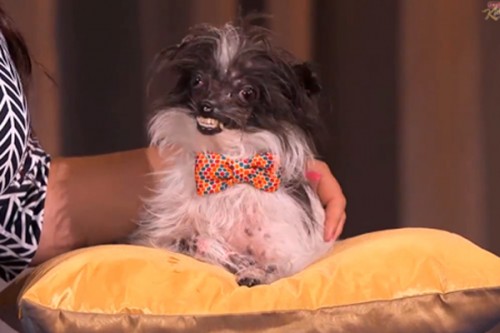
He looks beautiful, doesn’t he?
There isn’t much you can change about Peanut to make him into a different dog. A bowtie and combing doesn’t change much about the pain and suffering this friendly dog went through to get to where he is.
A makeover is a nice gift, but truthfully Peanut should be proud to be who he is. You do you, Peanut. We love you just the way you are.
Peanut and his human live in Greenville, South Carolina. They entered Peanut in the contest in order to raise awareness around the subject of animal abuse.
Veterinary Eye Doctors Rally to Aid Assistance Dogs
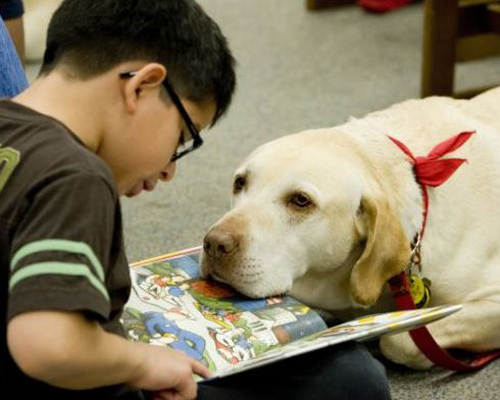
Free eye exams were given in May as part of an American College of Veterinary Ophthalmologists campaign designed to honor their public work. Nearly 29,000 service animals have been examined over the seven years of the National Service Animal Eye Exam Event, the ACVO reports.
Nearly all the patients examined this year were dogs employed as guide, handicapped assistance, detection, military, search and rescue, or registered therapy animals, but horses and a donkey were checked as well. Over 250 board-certified veterinary ophthalmologists participated in the event in the United States, Canada and Puerto Rico, looking for everything from eye redness, squinting and cloudy corneas to retinal disease, early cataracts and other abnormalities.
“Early detection and treatment are vital to these working animals,” says Stacee Daniel, executive director of the Meridian, Idaho-based ACVO. “Our hope is that by checking their vision early and often, we will be able to help a large number of service animals better assist their human friends.”
Success was measured not only by what the ophthalmologists did or didn’t find but also by the response of the animals’ owners. “Special thanks go out to the service animal owners who posted notes of gratitude on our Facebook page,” Daniel says. “Those kind words help our ophthalmologists and sponsors know that they made a positive impact, thus making them more likely to continue to participate in the future.”
Sponsors included Mount Laurel, N.J., drug compounder Stokes Pharmacy, medical device maker Welch Allyn Inc. of Skaneateles Falls, N.Y., and other industry partners. Exams are provided to active working animals certified by a formal training program or organization and those enrolled in a program.
Robin Williams Leaves Behind Family and Pug, Leonard
An icon has died today and yes, I realize we don’t typically cover this type of celebrity news. But I could not help but feel compelled to write about and pay some kind of tribute to this amazing talented and unique, actor, comedian, father, husband and dog lover.
Various new sources popped up onto my screen, reporting the same sad news that less than a mile from my own home, Robin Williams was found dead in his house in Tiburon, California. According to law enforcement reports, the 63-year-old, apparently took his own life.

Something not everyone may know is that Robin Williams was a dog lover, or rather, had a dog that he loved and was also a supporter of dog rescue. His Pug, “Leonard Bean” who was adopted from the Curly Tail Pug Rescue in New York city was regularly featured on the comedians twitter account.
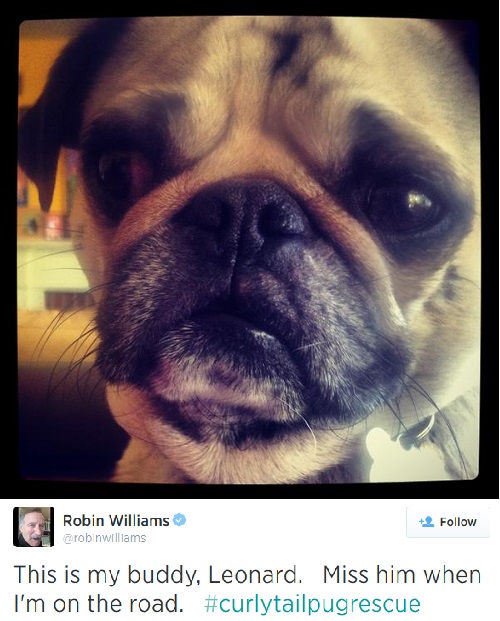
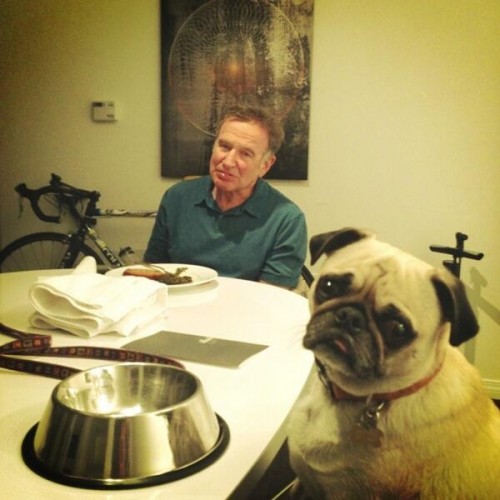
“I also have a gay rescue pug called Leonard, who I take for walks because I am very secure in my sexuality. He has a boyfriend and they are planning to adopt a Siamese kitten together. We’re very modern,” Williams says in a interview with the Telegraph.
In an AmA Williams told reddit, “for pure loyalty, there is nothing like a Pug.”
The two often donated images to rescues including a version of this one which was featured in the August calendar of Tony LaRussa’s Animal Rescue Foundation.
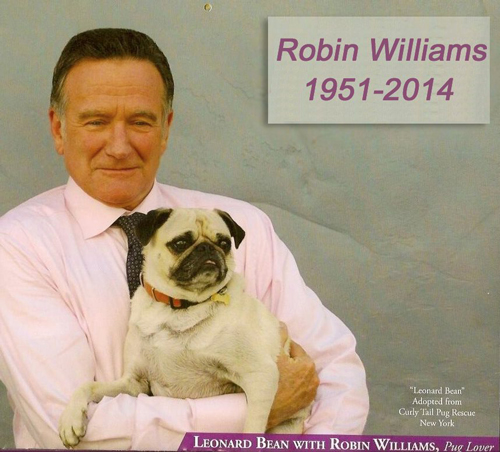
Dog Returned to Shelter for Farting Too Much, is Closer to Re-Adoption
If learning to tolerate the smell of another creature’s farts isn’t love, then I don’t know what is. The Greenville County Pet Rescue in South Carolina posted a photo June 26 on it’s Facebook page of a Pitbull mix named Misty who had recently been adopted and then returned. Sadly, this is a high-kill shelter, with a dog euthanasia rate of 23.4% in 2013. What was the reason for the return of the friendly pup? Her owners said she passed too much gas.
Many of the Pet Rescue’s followers came to the dogs defense and could not fathom returning a dog because of her natural bodily functions. Many were outraged. Most suggested changing the dog’s food, but the inspiring thing that happened was that people pledged money to the rescue to prevent Misty from being euthanized.
Due to the overwhelming Internet reaction, the loveable 1 year old dog was getting closer to adoption within days. Susan Bufano, a shelter spokeswoman, told the Huffington Post, “We are still evaluating her and have a foster for her. We anticipate finding her a home.”
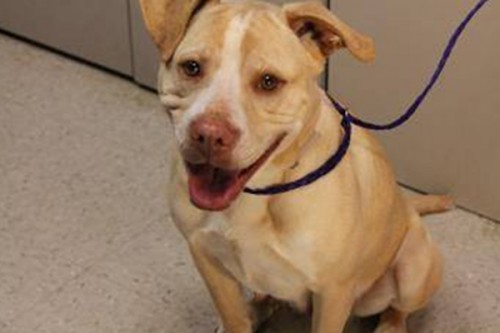
There is no question that the owners have the right to surrender the animal no matter what the reason is, but it is hard to look at this case from their point of view. Just like in cases of bad dog breath, there are also easy solutions when it comes to caring for a Flatulent Fido. Much easier and more humane, in fact, than returning the dog to a shelter in which he or she may be killed. One method is simply changing the food the dog is eating.
One Facebook user, Ginny Bowcock, summed up the sentiment of the rest of the users rather simply: “I wonder what these people do with their grandparents…put them in a farting home?”

Lauren Bacall, Actress and Dog Lover, Dies at Age 89
A star of Hollywood’s golden age, Lauren Bacall, died in New York City on Tuesday. Bacall was known for many memorable roles, co-starring many times with her husband, Humphrey Bogart in movies such as “The Big Sleep,” “How to Marry a Millionaire,” “Designing Woman,” “Key Largo” and “The Mirror Has Two Faces,” for which she was nominated for an Academy Award.
Besides her beauty and talent, the actress was well known for her love of dogs. In many photos throughout their lives, Bacall and Bogart were seen with their many dogs.
In an interview with NBC New York, Bacall’s neighbor Bill Karam, spoke of interactions with Barcall and his dogs. “She said to me, in this deep voice, ‘What’s your dog’s name? I said, ‘Blanche.’ And she said, ‘Miss Dubois?'” Karam said he last saw her about three months ago and she immediately recognized his dog. “She was always engaging with the dogs. She loved her dogs,” he says.
In 2008, Glenn Close visited Bacall and interviewed her about her love of dogs, specifically her Papillon Sophie.
“I was always a dog yearner. I didn’t have a dog growing up in the city with a working mother. As an only child, I yearned for someone to talk to,” Bacall tells Glen Close in an interview on BogieOnline. “When I was sixteen, we got a champagne-colored Cocker Spaniel and named him “Droopy.” He was very male. From the first moment, he was very possessive of me. All my dogs have been possessive of me. We eventually mated Droopy and kept one of his girl puppies—Puddle. I went to Los Angeles for a screen test when I was eighteen years old. My mother followed me out later. The dogs came, too.”
We have compiled a collection of our favorite photos of the late glamorous actress, who truly knew what it meant to be a movie star.
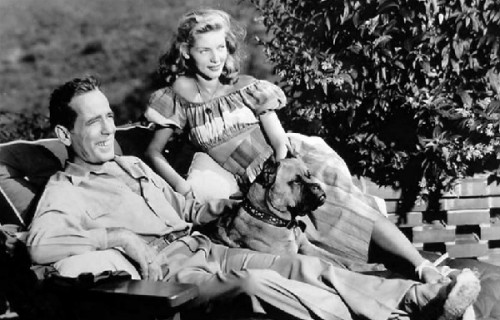
ACertainCinema
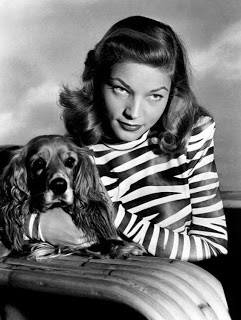
Jake-Weird
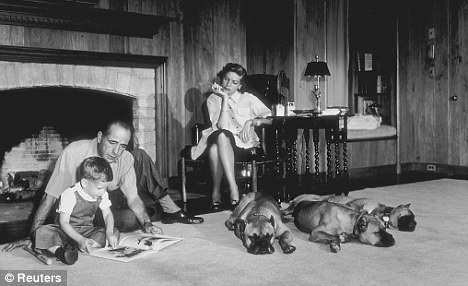
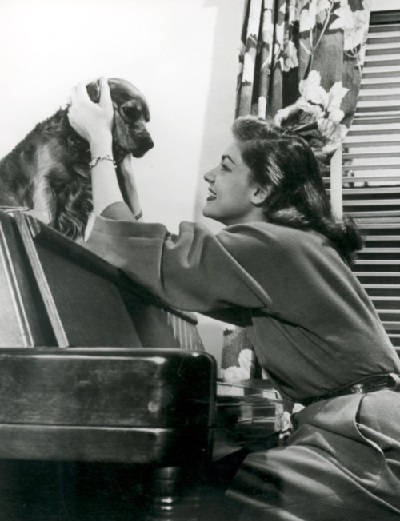
DailyMail
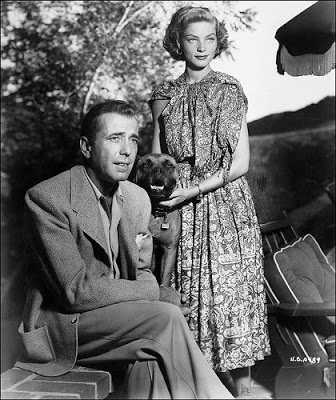
PuppyLovePreSchool
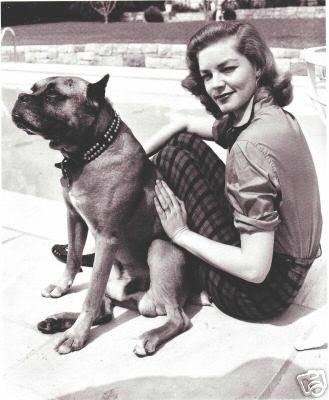
Pets4Ever
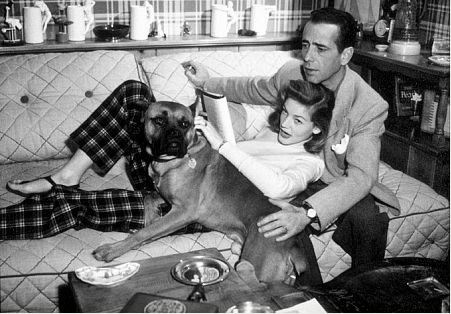
WideningCircle
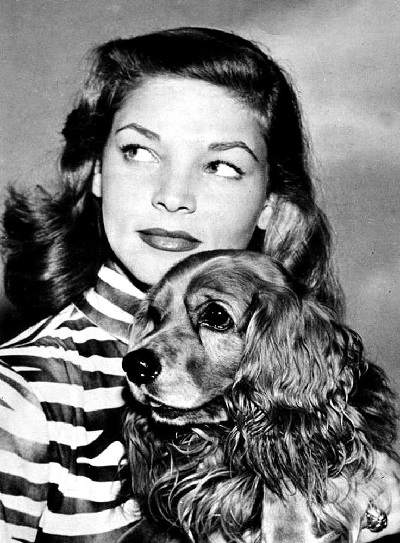
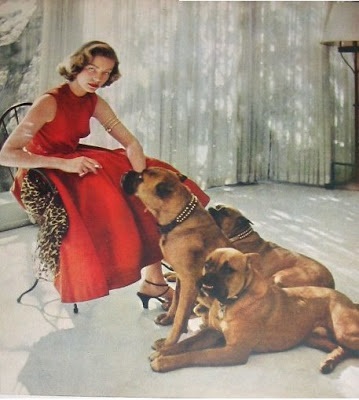
CashmereJeans
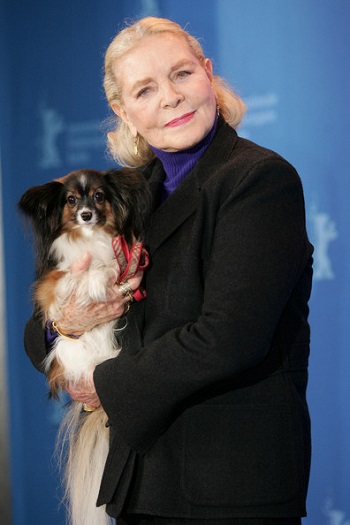
Zimbio
She will be dearly missed by many, but she will surely be met by many wagging tails.
Healing Puppy Power Put to Test for Childhood Cancer
Joshua sits on a hospital bed sobbing, surrounded by two nurses trying to insert an IV needle and by his Mom and Dad, trying their best to calm their scared and frightened four-year-old. But on this 6 a.m. Monday morning Josh, weary of his cancer battle, will have none of it. There have been too many needles. Now he is getting prepped for a third surgery. Joshua is a scared little boy and he knows what is coming, and he lets everyone within earshot know it.
Standing just outside the hospital room door I lift up my little therapy dog, Gordon, and we peek in. Immediately Josh’s Mom spots us, her eyes lighting up and she exclaims: “Josh, look, it’s Gordon! Gordon is here to see you.’’ They wave us in. Barely a minute or two later Josh is petting Gordon, sobs ebbing now into sniffles, focusing in our direction and his fluffy terrier pal, hardly noticing the IV connection being made on his other side.
A little dose of therapy dog can calm crying children, and ease the trauma and torment that sometimes comes with healing, for the patients, their families and the medical staff. A dog can make a sterile hospital room seem more like home, encourage kids who need to walk after surgery to get up and escort the pup around the hospital corridors, or just relieve the boredom of being stuck in a hospital room instead of being out with friends running around a playground.
In more than 6 years of making hospital visits with my wife Vicki, a longtime pediatric cancer researcher, and with our two therapy dogs, Gordon and Gypsy, we have seen them bring real therapy to thousands of people, both kids and adults. But until now there has been almost no real scientific “proof’’ of what therapy dogs contribute to healing, physical or mental.
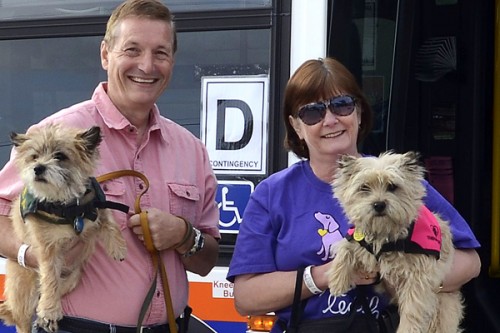
That may soon change.
The American Humane Association has teamed up with Zoetis and the Pfizer Foundation to launch a 15-month study designed to document the specific medical, behavioral, and mental health benefits animal-assisted therapy may have for children with cancer and their families.
“American Humane Association has a history of wanting science backing our initiatives,’’ says Amy McCullough, AHA’s National Director of Animal-Assisted Therapy. “In terms of animal therapy, obviously there is a gap there in terms of science supporting the benefits that we know sort of anecdotally that therapy dogs are giving us. With our mission being about helping both children and animals, we saw the need for this study to really promote how therapy dogs can help children who are dealing with cancer.’’
In exhaustive preliminary research, including a review of existing literature and a pilot study at two children’s hospitals, AHA found “therapy dogs are really important in pediatric oncology settings, and they aren’t allowed to visit necessarily in all children’s hospitals in these units, but the ones that we talked to really talked about the benefits.’’
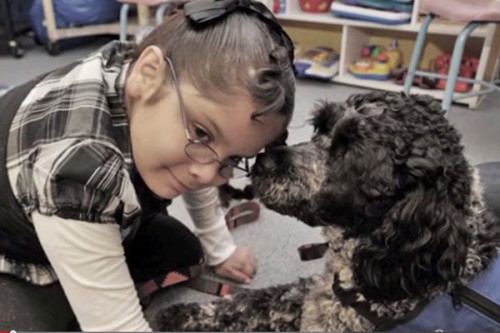
The full clinical trial will seek to confirm benefits identified in the pilot study, including:
Kids with cancer who are visited by therapy dogs have less stress, anxiety, and an improved, health-related quality of life
“Children with cancer and their families are not just dealing with physical concerns, there are also psychological issues – depression, anxiety, loneliness, being away from their classmates and school,’’ McCullough explains. “So these can have longer-term effects. We really want to show how animal-assisted therapy could be a really promising intervention to help not just the patient but the whole family interacts with the therapy dog, touching so many people there in a stressful situation.’’
Not only do the dogs themselves not get stressed by the visits, in fact the visits are mutually beneficial interactions
“The pilot study shows that post visit, the therapy dogs’ cortisol levels were lower than their baseline, indicating that they did not experience stress after visits,’’ McCullough says. “We also videotape the sessions using an ethogram to code the dogs’ behavior throughout the session, looking for signs of stress, whether it is yawning, lip-licking, looking toward the door, those kinds of things.’’
The five children’s hospitals participating in the study are:
St. Joseph’s Children’s Hospital in Tampa
Randall Children’s Hospital at Legacy Emanuel in Portland
UC Davis Children’s Hospital in Sacramento
UMass Memorial Children’s Medical Center/Cummings School of Veterinary Medicine at Tufts in Worcester/North Grafton, MA
Monroe Carell Jr. Children’s Hospital at Vanderbilt in Nashville
This study is personal to me and my wife. Today and every day, more than 35 children and their families will get a cancer diagnosis. In total, more than 40,000 children in the U.S. undergo cancer treatment each year.





